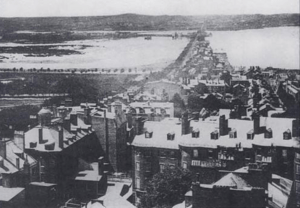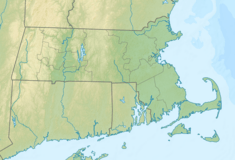- This page was last modified on 17 October 2025, at 10:18. Suggest an edit.
Boston & Roxbury Mill Dam facts for kids
| Boston & Roxbury Mill Dam | |
|---|---|

An 1858 view of the Boston Milldam
|
|
|
Location of Boston & Roxbury Mill Dam in USA Massachusetts
|
|
| Location | Boston, Massachusetts |
| Coordinates | 42°21′13.19″N 71°4′44.63″W / 42.3536639°N 71.0790639°W |
| Purpose | Industrial production, transportation |
| Construction began | 1818 |
| Opening date | 1821 |
| Construction cost | $700,000 ($221 million with inflation) |
The Boston & Roxbury Mill Dam was a huge engineering project in Boston's Back Bay area. It was planned in 1814 to create a large water basin. This basin would use the ocean's tides to power factories. The dam also created a new road. This road helped reduce traffic on Boston's busy Orange Street. The dam was built between 1818 and 1821. It extended Beacon Street further west.
Contents
What Was the Boston Mill Dam?
The Boston Milldam was built where the western part of Beacon Street is today. Before the dam, Beacon Street ended at Charles Street. The tidal waters of the Back Bay stopped it from going further.
The dam had two main parts, like arms. One arm stretched from Beacon Hill to a place called Sewall's Point. Today, this is Kenmore Square. The other arm went from Roxbury's Gravelly Point. These parts of the dam created a 600-acre basin. This basin held the tidal waters. Later, this entire water area was filled in. Now, it is the Back Bay neighborhood.
Why Was the Dam Built?
The idea for the Milldam came from Uriah Cotting. He was a businessman known for developing the Boston waterfront. He thought of the idea because there weren't enough factory goods during the War of 1812. Cotting believed Boston's strong tides could power many factories.
On June 14, 1814, the Massachusetts Legislature approved building the dam. However, the economy was slow after the War of 1812. This delayed the start of construction. Even so, many business people wanted to invest in the dam. Cotting predicted the dam would power 81 factories. He thought it would cost $250,000 but bring in $520,000 each year. It would also create a new road to towns like Brookline, Brighton, and Watertown.
How Was the Dam Constructed?
Construction of the dam began in 1818. It continued until 1821. Sadly, Uriah Cotting passed away in 1819, two years before the dam was finished.
The dam was built using stone. One part stretched from the foot of Beacon Hill to Sewell's Point. This area is now Kenmore Square. A second dam was built across the water from Gravelly Point in Roxbury. This divided the Back Bay into two basins. Together, these basins covered 600 acres.
At high tide, water from the Charles River would flow into the western basin. Then, it would pass through special channels. These channels were designed to generate power for factories. When the tide was low, the water would flow back out into the Charles River.
Why the Dam Didn't Work
The Boston Milldam project is generally seen as a failure. It cost much more than planned. The original estimate was $250,000, but it ended up costing nearly $700,000. Also, only three factories were built along the water. This was far fewer than the 81 factories that were predicted.
Another big problem was pollution. Once the dam enclosed the water, it became still and dirty. This caused a bad smell. Many people living in Boston complained about it. Uriah Cotting's reputation was saved because he died before the dam was completed. However, the Boston & Roxbury Mill Corporation faced many problems because the dam didn't work as planned.
The Milldam stayed in place for several more decades. Eventually, people wanted to use the dirty bay for something useful. So, the Back Bay land reclamation project began in 1857. This project aimed to fill in the tidal basin. New neighborhoods would then be built on this new land. The Boston and Roxbury Mill Corporation gave up their rights to the land in 1859. A seawall was extended to help fill in the Back Bay mudflats. Because the Milldam failed, the Back Bay did not become an industrial area. Instead, it became a beautiful neighborhood with many 19th-century homes.

